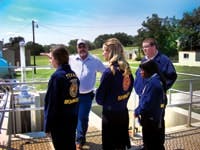David Harris grew up in a small town where he started mowing grass at the local water and wastewater treatment facilities before he was old enough to drive. He continued working for the city through high school and college in between semesters.
After college, Harris stayed in the water and wastewater treatment industry. He has been a licensed operator for more than 20 years and holds Class A Water Treatment, Wastewater Treatment and Municipal Solid Waste licenses.
Water runs deep in Harris’ blood. “My mother and father were both Class C Water and Wastewater [Treatment System] Operators,” Harris said. “They retired a few years back after 30 years of service.”
Today, Harris is the director of utilities for the city of Brownwood, Texas.
“I am currently the director of four departments: Water Distribution, Wastewater Collection, Wastewater Treatment and Streets,” Harris said. “I manage 60 employees and just over $10 million annual budget.”
Dramatic Transformations
Brownwood is located close to the geometric center of Texas and is the largest city in a seven-county area. The Brownwood Wastewater Treatment Plant (WWTP) evolved from a city-owned treatment plant in the 1900s. In the ’30s, a military treatment plant was built to serve Camp Bowie, a large U.S. Army training camp housed in Brownwood. In the mid-’50s, the base closed and the military plant was rehabbed and given to the city of Brownwood.
“It was a trickle filter plant with primary sedimentation, anaerobic digesters, two-stage trickle filters and clarification with chlorine contact afterwards. Drying beds were used for solids disposal,” Harris said.
In 1988, the WWTP added a mechanical bar screen, aerated grit removal and a flow equalization basin for high flows. It also added sand filtration to reduce TSS and split the flow with the addition of a package plant. In 1993, the plant continued its dramatic transformation by changing to extended aeration. Two Eimco Carrousels—oxidation ditch systems—were added with two conventional circular clarifiers, and the trickle filters were removed. This improvement project was funded by a Texas Water Development Board loan through the State Revolving Fund. The plant currently is rated at 4.54 million gal per day (mgd) and serves approximately 24,000 people.
“The 1993 equipment and most of the 1988 improvements are still in operation,” Harris said. “We are in design now to upgrade or replace many of the components, such as the headworks, removal of primary clarification and anaerobic digestion to aerobic, [as well as] changes in the aeration and treatment process to improve nitrogen and phosphorous treatment for future permits.”
Head-On Challenges
Like other facilities around the country, Brownwood faces its own region-specific challenges. Severe droughts followed by floods are a growing problem. Inflow and infiltration (I&I), headworks issues and solids handling constitute most of the problems, according to Harris.
“I&I can be a killer when you have clay mains and services,” Harris said.
Brownwood is addressing these challenges head on. This year, the city is moving forward with plans to build an estimated $8.2-million water treatment plant that would add at least 1.5 mgd of treated wastewater to the city’s drinking supply. The new plant will use Type I treated wastewater effluent as the source water for a potable reuse supplementary water system.
“The water treatment facility will take the water straight from the WWTP to an advanced water treatment plant and back into distribution,” Harris said. “Water was analyzed at the outfall last winter. The water [met] all primary drinking water standards except for nitrites and potable disinfection credits. My guess is that not many WWTPs in the world can make that claim.”
Key to Success
According to Harris, knowledgeable staff is key to Brownwood’s success.
“Without competent, hard-working staff, no design improvements, capital upgrades or new policy will work. Utility staff and operators are what really keep our water safe to drink and our wastewater treated, to not only protect, but also improve the environment every day,” Harris said. “Police and fire departments are very good to have on the chance situation that you need them, but you need potable water, sewer and sanitation service every day. High-level service of water, sewer and trash is what separates us from third-world countries and allows us to live a comfortable, safe life.”
Download: Here


